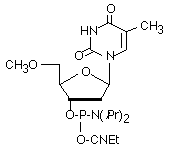Glen Report 20.16: Technical Brief - New application for 5’-OMe-dT phosphoramidite
In a paper published in the February 2008 issue of RNA, a group of researchers has shown1 that 5’-OMe modification of a strand of a ds-siRNA can control guide strand selection and targeting specificity.
It is known that siRNA- and miRNA-containing ribonucleoprotein silencing complexes (RISC) are formed from short double-stranded RNA. Duplex siRNA is basically symmetric. However, only one strand enters the RISC and there is a bias for the preferred loading of one of the two duplex-forming strands into the RISC. Recruitment of the “wrong” strand can reduce expected activity and generate off-target silencing.
In their RNA paper, the authors have shown that the 5’-phosphorylation status within a duplex siRNA is an important determinant of strand incorporation into RISC. They also demonstrated that selective asymmetric 5’-O-methylation of one strand of an siRNA duplex can be used to direct the non-methylated strand to be incorporated into RISC. The off-targeting activity of the 5’-O-methylated strand was reduced, while the off-targeting activity of the phosphorylated strand was enhanced. They concluded that asymmetric 5’ modification of siRNA duplexes can be extremely useful for controlling targeting specificity.
This simple and effective modification of siRNA can be readily achieved using our product (5’-O-Me-dT phosphoramidite; 10-1031).

5'-OMe-dT
Reference
- P.Y. Chen, et al., RNA, 2008, 14, 263-274.
Product Information
- Glen Report 20.11: An Unnatural Base Pair System for the Expansion of Genetic Information
- Glen Report 20.12: Thiophosphoramidites and Their Use in Synthesizing Oligonucleotide Phosphorodithioate Linkages
- Glen Report 20.13: Technical Brief - Purification of 6-FAM Labelled oligos using Glen-Pak™ Cartridges
- Glen Report 20.14: More Click Chemistry
- Glen Report 20.15: Technical Brief - New application of 5-Me-iso-dC and iso-dG
- Glen Report 20.16: Technical Brief - New application for 5’-OMe-dT phosphoramidite
- Glen Report 20.17: New Product - Deuterated 2’-Deoxyguanosine Phosphoramidite
- Glen Report 20.18: New Products - Solid CPR II / Formylindole – Aldehyde Modifier
- Glen Report 20.19:New Product - 5'-Cholesteryl-TEG Phosphoramidite
- Glen Report 20.110: Improving Universal Support II for Oligonucleotide Synthesis
- Glen Report 20.111: Differences Between Universal Support II and III
- Glen Report 20.112: Technical Brief - Phage Display, Artificial Antibodies and Trimer Phosphoramidites

